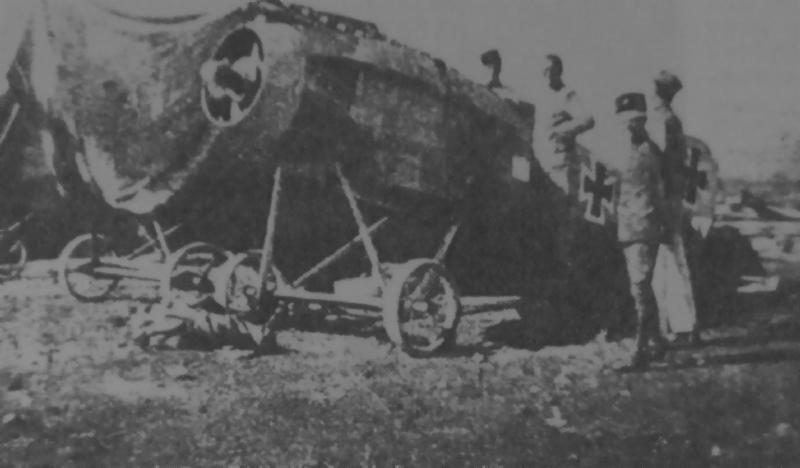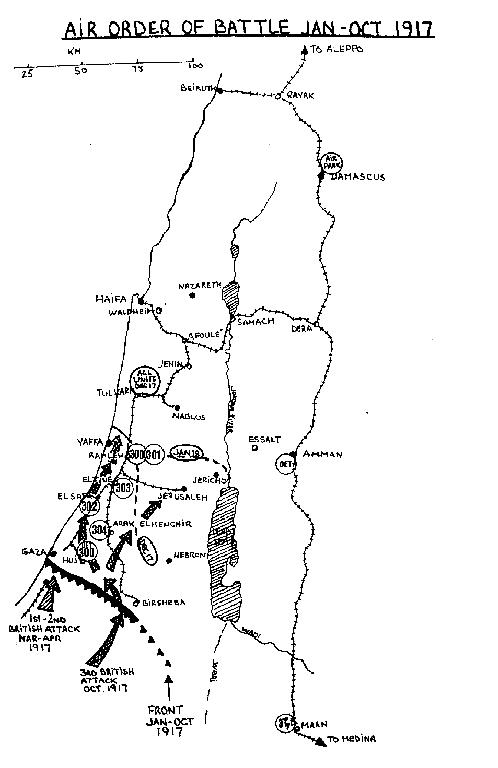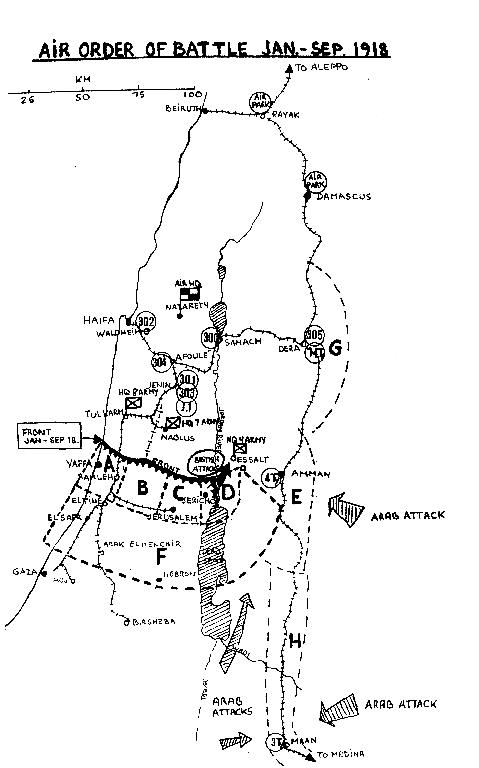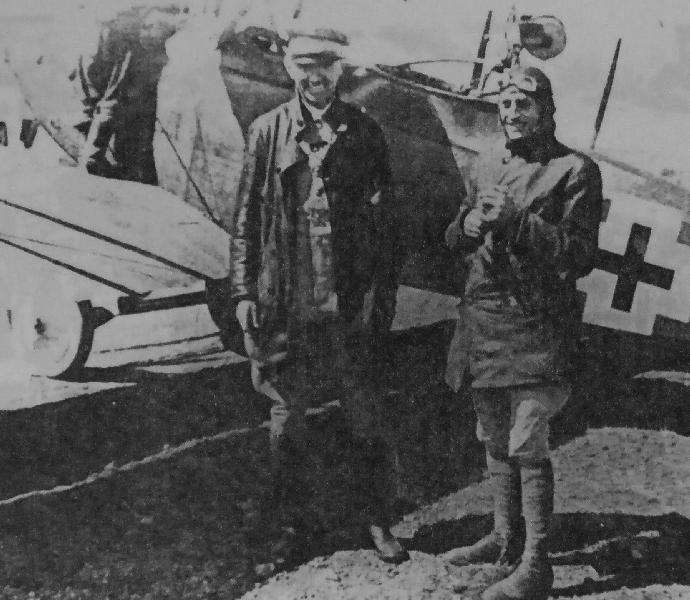Topic: Tk - Bks - Air Force
Pasha and Yildirim, the Palestine Front, 1915 to 1918

[From: Ole Nikolajsen, Ottoman Aviation 1911 - 1919, p. 207.]
Part 5 - Yildirim Ordu (The "Lightning Army")
The news of the fall of Baghdad to British forces on 11 March 1917 was received with shock and disbelief by the Turkish public. Immediately it was demanded that this important city should be retaken. The Turkish Army Command consequently drew up plans for the reconquering of the city by forming two new armies (the 7th and 8th) and by securing a new German Corps (the "Asian Corps") of 15,000 men. Four German and two Turkish aircraft units were to be formed for these armies. In Germany the former Commanding Officer of FA300, Major Heemskerck was promoted to "Kommandeur der Flieger" (KOFL) and entrusted with the formation of 3 Prussian and 1 Bavarian "Fliegerabteilung", FA301, FA302, FA303. and FA304(b).
During June and July these units with each 6 AEG C.IV's and 2 Albatros D.III's as well as 4 reserve AEG's and 2 Albatroses were formed. The large quantities of material and men for both the armies and flying units started to arrive in Istanbul in late July. At this point it realized that the Gaza force was so depleted of men and material that, drastic measures were needed. Consequently in the first week of August the "Yildirim Ordu" (the "Lightning Army"), as the venture was known, was ordered first to Gaza to defeat the British Army there and then to divert towards Baghdad.
The build-up of the entire force was painfully slow however as the railway through Anatolia and the unfinished tunnels [184] in the Tauras mountains were bottlenecks unable to absorb the flow of masses and material.
Major Heemskerck arrived, as the first of 80 officers and 800 NCO's and men in the beginning of September 1917 at Ramleh, the Headquarters of the FA300, together with the first aircraft unit, FA301 under command of Captain Bieneck. Initially 4 AEG C.IV's and 2 Albatros D.III were available. The rest of the units were held back at Istanbul when on 6 September the railway station at Haydarpasha on the Asian side of Istanbul was demolished in a devastating fire. FA304(b), the Bavarian unit, under Captain Walz had been caught by the fire at Haydarpasha and lost 5 of its aircraft.
FA302 with Commanding Officer Captain König and FA303 with Capt. Schumburg, each with 6 aircraft, arrived at the front on the 11th of October and they were based at new fields prepared near El Safid and El Tine. It was not until 25 October that FA304(b) arrived at its designated field close to the railway station of Arak el Menshiyeh. All aircraft units based in Palestine had their fields located alongside the railway line to facilitate supply.
At this time the former advantage of the German units at the front had deteriorated. New aggressive tactics in the air from squadrons of the recently formed Royal Air Force had resulted in the downing of a newly arrived AEG on 25 September and on 8 October one of FA300's Albatros D.III's was forced down by enemy fighters and captured. [See: Gustav Adolf Dittmar.] Four British SPAD fighters surprised a formation of AEG's on 15 October and shot down one. Soon large formations of British aircraft blocked any attempts by the German aircraft to reconnoitre the front as was a prerequisite for victory in March and April. Despite this, a few missions got through and on 22 October, ships were observed moving north along the coast. On 25 October an aircraft reported that large formations of British cavalry were moving towards the central Gaza lines. [See: The battle of El Buggar Ridge.] A British attack was evidently imminent. This time however every effort had been made by the British to hide the objective of attack. Large dummy camps had been constructed in Cyprus to make the Ottoman Army Command believe that the attack would be made behind the lines in Lebanon and the French navy aircraft launched an attack on Beirut. On 17 October this deception was revealed by a four hour reconnaissance performed over the island by 2 AEG's from FA302 from which had started out from Silifke, in southern Turkey. [185]
The cavalry formations observed on the 25th near Gaza were in fact also a plot conceived by the British to make the Turks believe that the attack would come there. The actual attack was initiated with complete surprise in the evening of the 27th on the feeble garrison at Beersheba and the post fell the next day. [Editor’s note: The battle fought on 27 October was at El Buggar Ridge. The Battle of Beersheba was fought on 31 October 1917 with the first attacks launched at about 8am.]
Map of air activities covered by this extract
[From: Ole Nikolajsen, Ottoman Aviation 1911 - 1919, p. 182.]
[Click on map for larger version.]
A Rumpler from FA300 had managed to spot this on 27 October, but luckily for the British, the aircraft was shot down on its way back and the crew taken prisoner. Its observer was the famed Captain Falke. The British attack now rolled towards Gaza from the flank and another German aircraft was lost on 28 October. In the next 2 days seven more air battles were fought without victors. The Gaza fortifications were attacked on the 2nd of November and on this day 5 British aircraft were claimed shot down by the able gunners of the Austrian anti-aircraft battery and two more by fighters. The British having learned from previous experience managed with fighters and anti-aircraft guns to keep the artillery spotting German aircraft away from the front. [Editor’s note: The breakthrough at Tel el Sheria and Gaza occurred on 7 November 1917.]
Then the British intensified their efforts and on the 8th of November a large formation of aircraft bombed the field at Arak el Menshiyeh, the newly arrived FA304(b) being taken by surprise. [See: 9th LHR AIF War Diary, 8 November.] One aircraft was destroyed and 4 others damaged. When the airfield was evacuated later in the afternoon, after the British had broken through the front, these aircraft had to be burned by its crews. While most of the personnel of FA304(b) were rescued by the unit's trucks, only two aircraft were flown to safety. On 9 November, FA303 was bombed at its field near El Tine and when this field was evacuated three aircraft were left behind. The FA300 did not possess trucks and was rescued with vehicles coming from the German colony at Sarona. The British advance had such momentum that Ramleh was overrun by 15 November and it was only on 21 November that it was stopped, 5 miles from Jerusalem. This mainly because of heavy rain.
During the advance an Albatros fighter was lost on 12 November and two AEG's were shot down by enemy ground fire on 17 November. By the 2 December the rain ceased to such a degree that the British advance was resumed. On the same day a formation of 20 AEG's escorted by 5 Albatrosses attacked the new British airfield at Julis. The formation was during its attack intercepted by SPAD's but no losses were suffered.
Jerusalem was taken by Allenby's forces on 7 December 1917.
At the beginning of December most of the German aircraft and their units had been relocated to Tul Karm, but this was [186] observed by the British and after having been bombed, the units retired further north. The FA300 went to Samach, FA301 and FA303 went to Jenin, FA302 went to the German Jewish colony at Waldheim and finally the FA304(b) went to Afuleh. From these new locations both an AEG and an Albatros were lost on 17 December.
The British attack finally came to a halt south of a line 20 km north of Jaffa to Jericho.
In the effort to halt the enemy advance, however, 10 German aircraft had been lost in the air and 8 on the ground, with 9 pilots and 2 observers killed and 8 pilots and 5 observers wounded. Against 18,000 British army casualties the Turkish and German forces lost about 25,000 men while another 12,000 were captured as Prisoners of War.
By the New Year, 1918, the front had stabilized and the German air units somewhat recovered and reorganized at their new bases. In order to counter the enemy fighter squadrons the 7 remaining Albatros D.III fighters were collected into a provisional fighter "staffel", called JASTA 1, at Jenin. The unit came under command of Lieutenant Felmy, younger brother of Captain Felmy, Commanding Officer of FA300 and personnel was drawn from the other units as well as FA300.
Map of air activities covered by this extract
[From: Ole Nikolajsen, Ottoman Aviation 1911 - 1919, p. 188.]
[Click on map for larger version.]
The JASTA 1 operations were organized with in conjunction with FA301 and FA303 from Jenin being attached to the 7th Army commanded by Fevzi Pasha (area C and D on map.). FA300 from Samach and FA302 from Waldheim were attached to Cevat Pasha's 8th Army (area A and B on map) whereas FA304(b) was entrusted with general reconnaissance (area F). The Turkish aircraft companies 3ncü and 4ncü Tay. Böl. as well as a detachment of FA302 were given duties on the eastern front (4th Army area E on map). From February onwards the new FA305 and 14ncü Tay. Böl. at Dera were assigned area G. For these large operational areas and numerous duties about 30 AEG C.IV's were available for the German units and 4 Albatros C.III, 6 Rumpler C.I’s and 10 AEG C.IV’s for the Turkish units.
Further Reading:
9th LHR AIF War Diary, 8 November
Air War on the Palestine Front, December 1915 to January 1917
Turkish Units - The Ottoman Air Force
Lieutenant Colonel Hüseyin Hüsnü Emir, Yildirim
Go To:
Previous Chapter: The First and Second Battles Of Gaza
Citation: Yildirim Ordu (The "Lightning Army")









